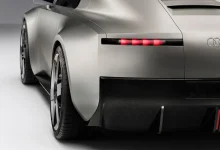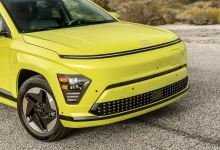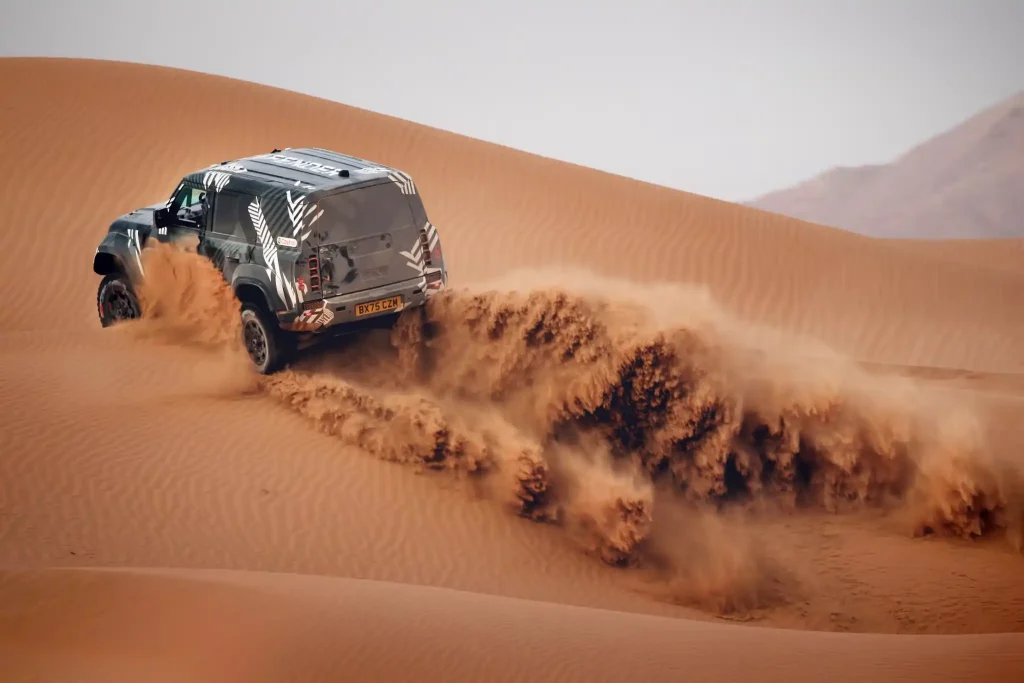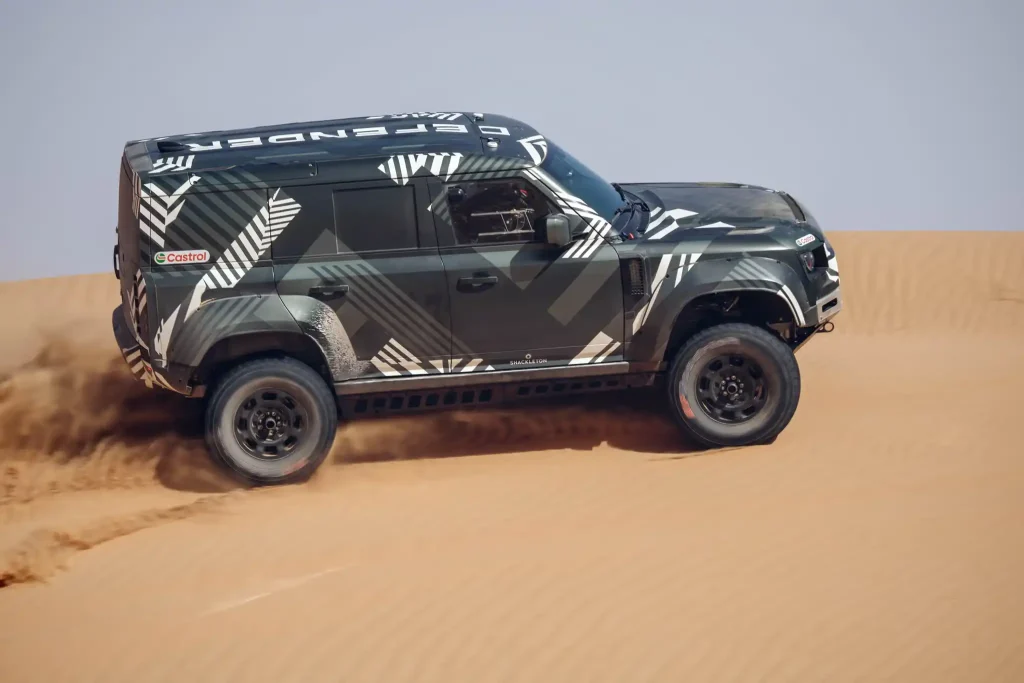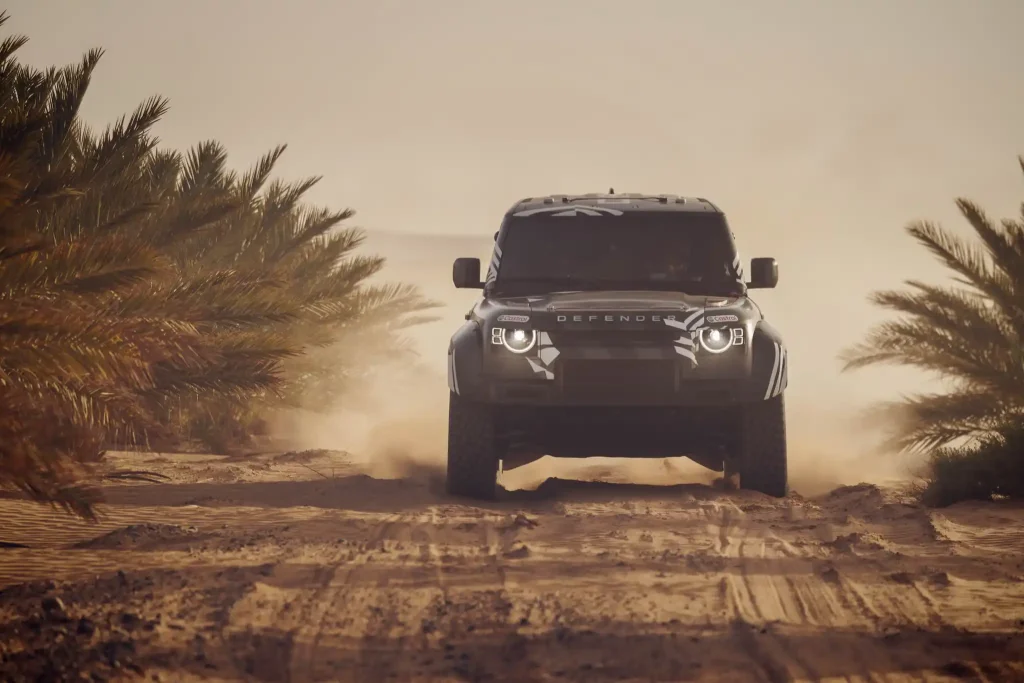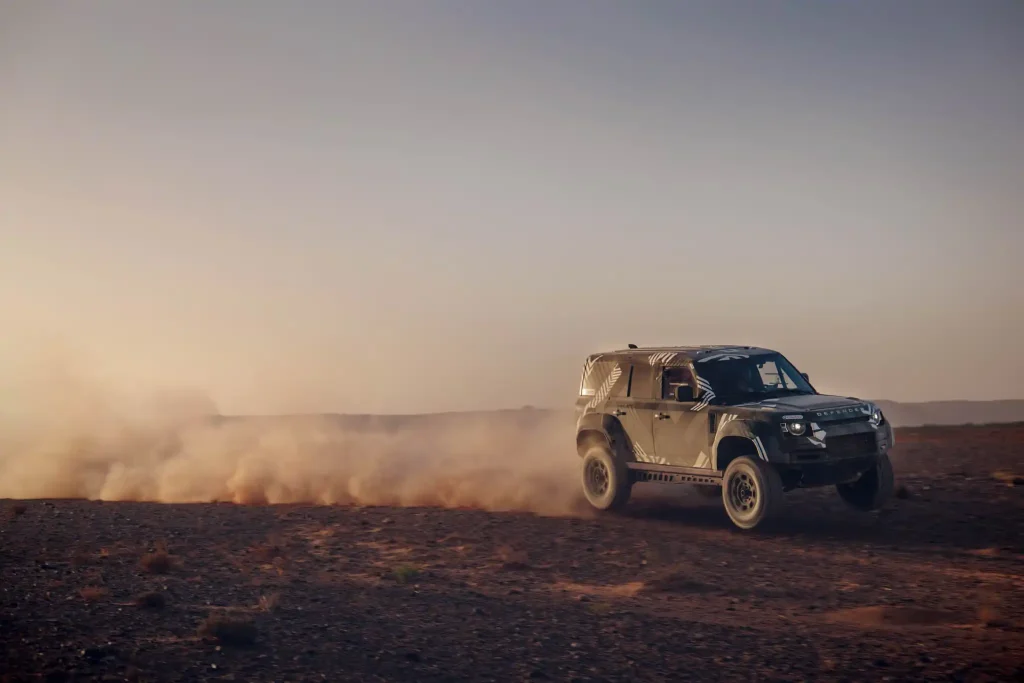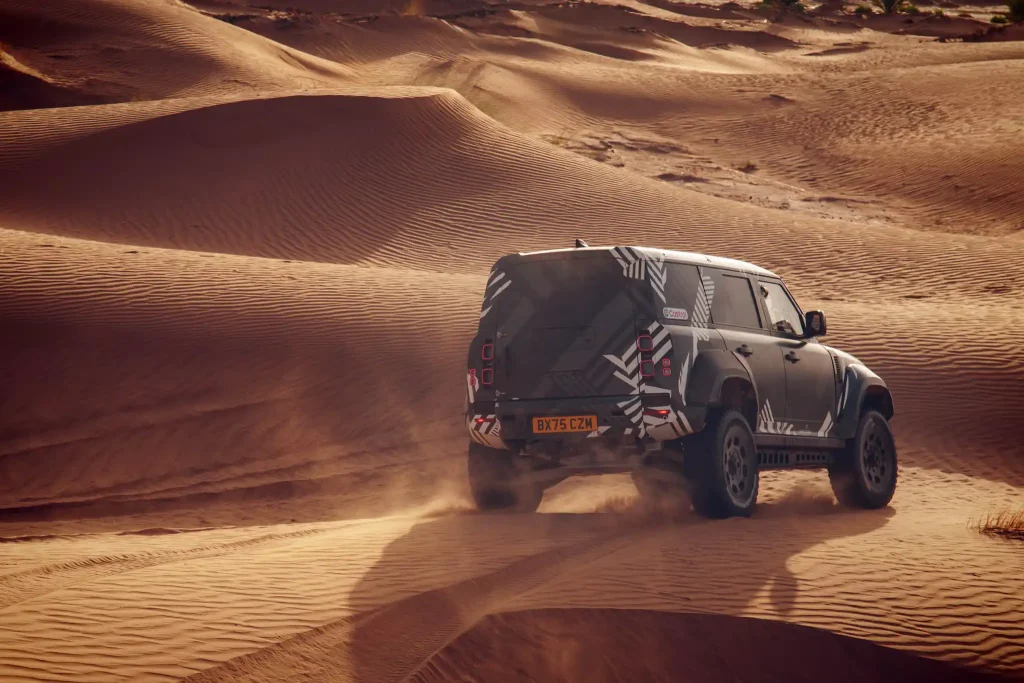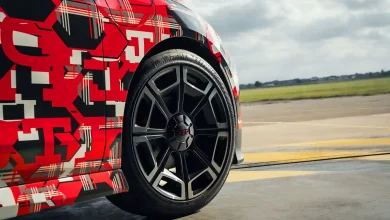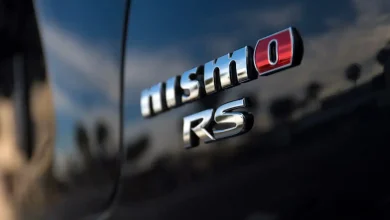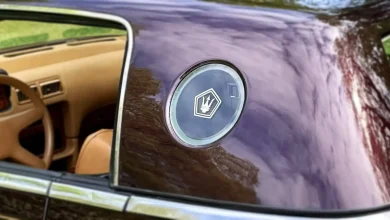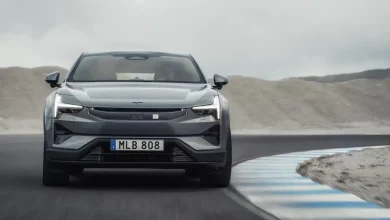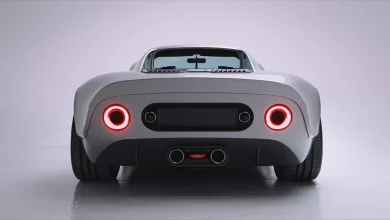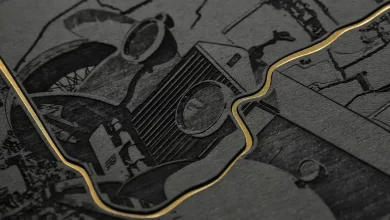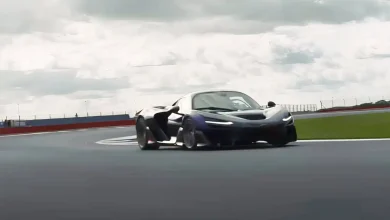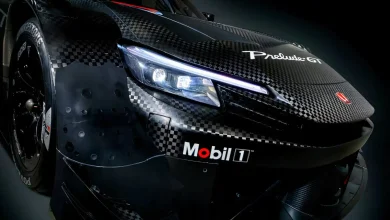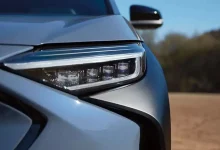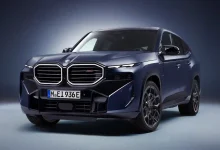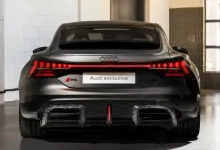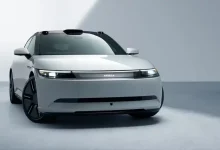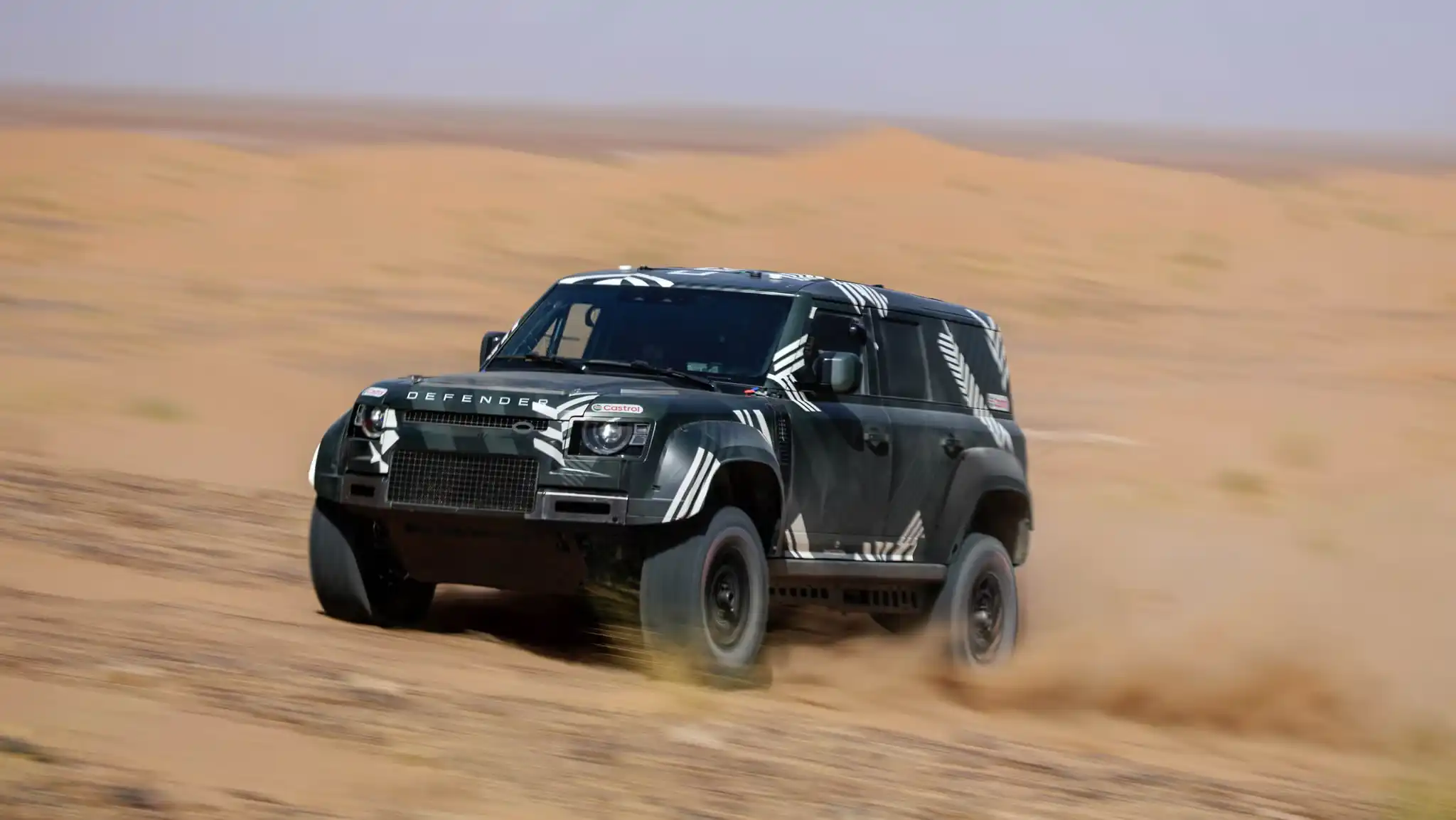
Standing in the Sahara, the word “desolate” suddenly feels like an understatement. I spin in a full circle, scanning the horizon—there’s nothing but sand, sky, and the truck that brought me here. No signs of human life. Have they ever existed?
In the distance, a conical dust cloud emerges, accompanied by the raw roar of an unmuffled V-8. At its center, a small dark shape tears across the barren landscape. The dust cone stretches, then flattens into a circle as the shape veers and barrels straight toward me. As it closes the distance, I recognize it: a Land Rover, surging across the desert at over 100 mph, leaving a trail of dust and thunder in its wake.
Just a couple hundred feet away, the furious machine strikes a sand mogul. Its tail leaps skyward, and the truck pirouettes on its front tires before settling, pointed straight at me. The rear axle reconnects with the ground, the driver twitches the wheel, and slams back into the throttle. Dust engulfs me as the cloud recedes, the dark green Land Rover Defender vanishing into the horizon.
I’m in Morocco to witness Land Rover’s very first test session with the prototype Defender D7X-R race car. That I’m still standing after that close encounter? A clear sign the test is going exactly as planned.
Land Rover has long been at home in the desert. Anywhere humans are strangers, Land Rover has likely already been. For decades, the brand’s enthusiasts have sought out the planet’s most remote corners, a pursuit Land Rover later celebrated with the Camel Trophy. That event demanded patience and precision—a thinking driver’s off-road challenge where problem-solving mattered as much as approach angles or fording depth.
The D7X-R, by contrast, is being built for the FIA World Rally-Raid Championship (W2RC), a world where problem-solving often boils down to one solution: more throttle—even when that “problem” is a car hurtling toward bystanders.
The W2RC campaign marks Land Rover’s first-ever factory entry into any racing series—and the company is so fully committed that even a seasoned Camel Trophy veteran might worry about the height of his snorkel. The season kicks off in January in Saudi Arabia with the Dakar Rally, a grueling cross-country ultramarathon roughly equivalent to running five Baja 1000s back-to-back over two weeks, with only two brief rest days. Land Rover isn’t just dipping a toe in—they’re signed on for the full W2RC calendar for at least three years and even played a role in helping the FIA rewrite its class regulations.
Dakar is what earns this beefed-up SUV the “race car” label. In the rally, “truck” refers to the T5 class—massive commercial machines from IVECO, Hino, and Tatra, rolling on 50-inch tires. They’re built to support other racers but compete fiercely among themselves. Compared to those towering monsters, the Defender barely qualifies as a truck—it’s a car.
In recent years, T2—the class for cars like the Defender—had been constrained by regulations. The vehicles remained too close to production models, making for competition that was exciting to drive but slow and unremarkable to watch. To fix this, Land Rover joined forces with Ford, Nissan, and Toyota to work with the FIA on a complete rule overhaul. The result was so thorough that the class even received a new name: Stock. Don’t be fooled—the cars aren’t stock in the traditional sense, but they’re not “stock” in the NASCAR sense either.
The main takeaway is that the new regulations are designed to let a variety of vehicle architectures compete on a level playing field, while keeping enough of their production roots to stay meaningful to fans. The Defender features an aluminum monocoque with subframes and independent suspension on all four corners. Ford’s Raptors stick to traditional body-on-frame construction with solid rear axles. The Toyota Land Cruiser and Nissan Armada (Patrol) fall somewhere in between, pairing full frames with independent suspensions.
Jaguar Land Rover’s head of technical integration, Jack Lambert, explains that for such diverse vehicles to compete in a single class, the regulations have to allow modifications appropriate to each platform. “Ford will want more wheel travel, bigger wheels and tires—that’s fine,” Lambert says. “What you can’t do is start stripping body panels, cutting giant holes in the rear, and removing the bed entirely.”
Land Rover, however, needed the ability to heavily modify the rear of the Defender. “It’s all cast, bonded, or riveted,” Lambert explains. “It’s aluminum; it’s not easy to work with. We can’t just weld reinforcements in. So, we have to redesign that structure, change the material, and actually add the support the back of the car needs.”
The regulations break down what can and cannot be altered for each vehicle subsystem. Some components allow flexibility, while others are tightly restricted. Suspension has some leeway, but, Lambert notes, race cars must retain the production vehicle’s “kinematic principle—the way the wheels move up and down and how they’re linked to the chassis.” Manufacturers can also adjust track width and ride height, which is where the new Defender Octa comes into play.
Stock-class cars must be homologated to a model with an annual production of at least 1,000 units. FIA inspectors recently visited the Defender line in Nitra, Slovakia, to verify documentation and inspect the VINs of every Octa produced in the last year—roughly 4,000 to 5,000 vehicles. Crucially, the Octa is 1.5 inches wider than the standard Defender, and the rules allow for up to 2.4 inches of additional track width over the homologation model. This gave Land Rover the ability to expand the D7X-R’s footprint by nearly four inches compared with the regular Defender.
“Suspension is where we’ve made really big steps in changing the car’s characteristics,” Lambert says. Inboard mounting points must remain stock, but on the D7X-R, these points are reinforced inside the bodyshell with steel backing plates that tie into the roll cage. The wider track comes from longer, stronger suspension links. With a 145-gallon fuel cell—roughly 900 pounds when full—and three 110-pound spare tires mounted over the rear axle, Land Rover fits two dampers in each rear corner instead of the Octa’s hydraulically interlinked 6D units. This allows finer tuning of damper behavior and provides redundancy if one fails. Lambert recalls our earlier close encounter with the D7X-R: that the rear of the car landed and immediately returned to driver control is a testament to the suspension’s ability to absorb massive impacts with composure.
Engine regulations, by contrast, are strict and straightforward. “It’s a production engine. Fully dressed,” Lambert explains. “You can change harnessing, control, or the ECU. Everything else must remain production.” FIA inspectors monitor the process meticulously: “They come in, the block goes on the line, they tag it, watch the entire build, put seals on it, crate it, and transport it to their facility for deconstruction. That becomes the reference for all our engines.”
In production trim, the Octa’s twin-turbo 4.4-liter V-8 delivers 626 horsepower—but that’s largely irrelevant for Dakar. Stock-class entries are limited to 6.5 kilograms (14.3 pounds) per horsepower. To maintain competitiveness, the D7X-R’s exact weight is a closely guarded secret, but with a roughly three-ton vehicle, that works out to about 400 horsepower, with a restricted air intake handicapping the V-8 to comply with regulations.
Class regulations require Land Rover to retain the Defender’s production transmission case, but allow modifications to the internals. Given the complexity of the ZF eight-speed automatic, the team opted for a simpler approach: adding an external cooler and tweaking the software to streamline operation. “The production unit is doing a lot of intelligent work for you,” Lambert says. “We don’t want any of that—none of the complexities. The complexity of the D7X-R’s drivetrain is in the drivers. It’s for them to decide how they want to drive the car. We need a gearbox that works in a simplified way but still lets them use the production system on their terms.”
“That’s the philosophy we apply everywhere,” Lambert continues. Drawing on his experience with Jaguar’s Formula E team, he contrasts the approaches. “In rally raid, you want simple systems. If something breaks in the field, it can be diagnosed, and the navigator knows exactly which buttons to press to reset a system and get back running—no need for four laptops and 20 engineers at the factory.” He calls this philosophy “consistent robustness.”
Aft of the ZF transmission, the transfer case is production-based as well, though low range is effectively disabled via software. Regulations allow an auxiliary cooler here too. Differential cases must remain stock, but internals can be modified. Instead of the Octa’s electronically controlled rear and open front differentials, the D7X-R uses mechanical limited-slip units front and rear. “It’s not about turning circle,” Lambert explains. “It’s about putting the car into a slide and letting all four wheels find traction. That’s how you build a fast rally car.”
A key to staying fast in rally raid is avoiding flats, and the D7X-R’s rugged wheel-and-tire setup comes with some compromises. It rides on 35-inch BF Goodrich KDR2+ tires, their massive sidewalls mounted on relatively small 17-inch wheels. “That 17-inch rim governs how big the brake package can be,” Lambert explains. “We’ve got a 355-millimeter rotor on a performance brake package, but for a car running near three tons, the physics are a challenge. The choice was to prioritize tire robustness and sidewall depth over braking performance.”
This highlights one of the major differences between Stock cars and the unlimited T1+ class. “They run 37-inch wheel-and-tire packages,” Lambert notes. “They can do more complex things with their braking systems. What we have is a restriction, which is exactly what this category is about—demonstrating the capability of the core platform.”
The regulations also please the marketing teams at Land Rover, Ford, Nissan, and Toyota, since the cars retain a strong visual link to production models. Aside from the wider stance and taller ride height, body modifications in Stock are tightly restricted. “I had four weeks of discussion with the FIA about what constitutes a bumper,” Lambert recalls. He had argued for a more radical change to the rear corner, where the fender trim wraps around to the back. But, he admits with a hint of regret, “I lost that battle.” As a result, the D7X-R more closely resembles the Octa from behind than the design team originally intended.
Inside the vehicle, teams are free to make any changes, but the Defender crew aimed to keep the interior as familiar as a bare-metal, caged race car can be. The signature “cross-car beam” dash structure remains, though the exposed magnesium of the production model is now wrapped in carbon fiber. The hockey-stick-shaped trim on the center console survives the transformation, though it, too, is now carbon fiber and houses water for the driver and navigator. Even the hydraulic handbrake handle is designed to echo the Octa’s shifter. “When you open the door of a D7X,” Lambert says, “you go, ‘Oh, that’s actually still a Defender inside.’ It’s just got a nav screen, relays, and the driver interaction panels and screens.”
One key difference between the D7X-R’s interior and the Octa on your local dealer’s lot is the driver’s seat. Among the three pilots contesting Dakar for Land Rover this year is Stéphane Peterhansel—a legend in desert racing. Peterhansel has entered the rally 35 times in the last 38 years and won 14 times, with two second-place and two third-place finishes. His record includes multiple back-to-back victories and even a three-year winning streak. In that context, his recent four-year gap without an outright win almost looks like a slump. Audi, his former team, struggled with the electrified RS Q E-Tron, which failed to finish in 2022, ’23, and ’24, ultimately withdrawing from Dakar 2025.
Peterhansel is the right driver for the job. Come January, Land Rover will have to prove that the Defender D7X-R is the ultimate tool for conquering Dakar.
